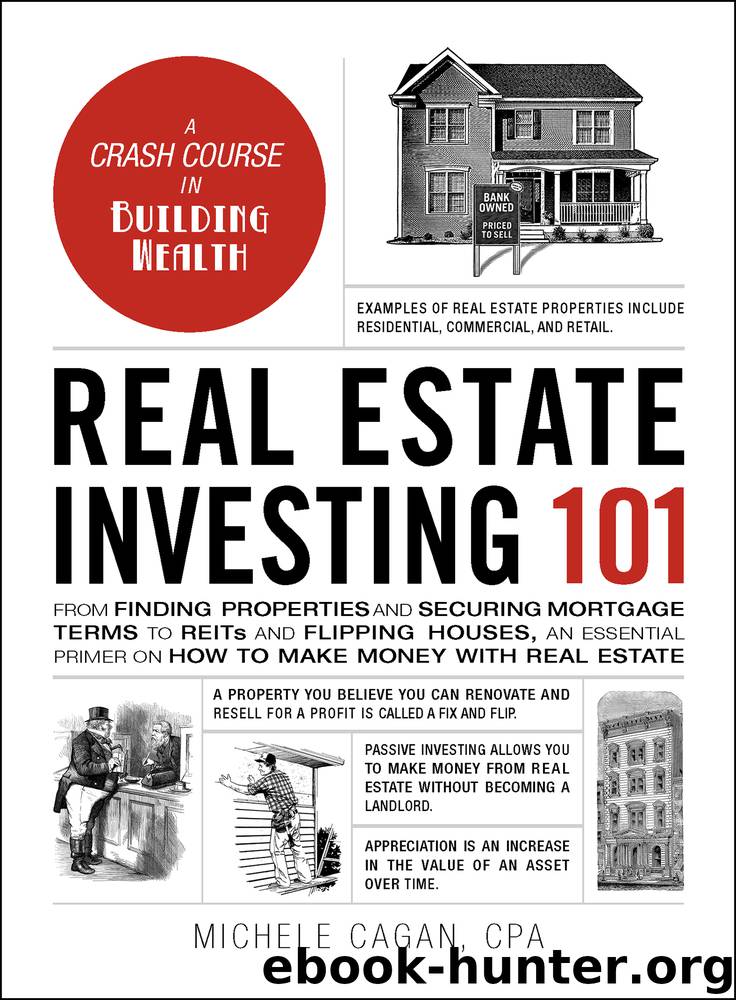Real Estate Investing 101 by Michele Cagan

Author:Michele Cagan
Language: eng
Format: epub, azw3
Publisher: Adams Media
Published: 2019-06-10T16:00:00+00:00
Choosing the Right Fund
Before choosing a real estate mutual fund to invest in, you’ll want to know what’s in its portfolio. At least 80 percent of a fund’s holdings have to be the investment type indicated by its name, but sometimes the names are (purposely) vague, allowing more flexibility. Make sure that the funds you consider actually contain the type of real estate investments you want.
You can narrow down potential picks using online fund screeners, available on sites like Morningstar (www.morningstar.com) and Kiplinger (www.kiplinger.com; click on the “Tools” section). If you already have a brokerage account, you’ll have access to all of their screening tools as well.
Some of the factors to compare include:
• Loads are sales charges that kick in when you buy (front-end load) or sell (back-end load) open-end mutual fund shares.
• Expense ratio refers to ongoing fees for the fund, which range from 0.09 percent to more than 3 percent; lower fees are associated with index funds, higher fees with managed funds.
• Minimum investment requirement for open-end funds typically ranges from $500 to $3,000 for the initial investment only.
• NAV (net asset value) equals the total current value of all assets held by the fund minus any outstanding liabilities divided by the total number of outstanding shares [(assets – liabilities)/shares].
Download
This site does not store any files on its server. We only index and link to content provided by other sites. Please contact the content providers to delete copyright contents if any and email us, we'll remove relevant links or contents immediately.
Periodization Training for Sports by Tudor Bompa(7348)
The MacArthur Bible Commentary by John MacArthur(4257)
The Body: A Guide for Occupants by Bill Bryson(3843)
The Sports Rules Book by Human Kinetics(3605)
What It Really Takes to Get Into Ivy League and Other Highly Selective Colleges by Hughes Chuck(3229)
Marijuana Grower's Handbook by Ed Rosenthal(3133)
The Sprouting Book by Ann Wigmore(3064)
Salt, Fat, Acid, Heat: Mastering the Elements of Good Cooking by Nosrat Samin(2669)
The Martian by Andy Weir(2627)
Classic by Mary Berry(2510)
The Bread Bible by Rose Levy Beranbaum(2487)
Sapiens and Homo Deus by Yuval Noah Harari(2429)
The Marketing Plan Handbook: Develop Big-Picture Marketing Plans for Pennies on the Dollar by Robert W. Bly(2423)
Harry Potter 4 - Harry Potter and The Goblet of Fire by J.K.Rowling(2423)
Martha Stewart's Baking Handbook by Martha Stewart(2340)
50 Economics Classics by Tom Butler-Bowdon(2072)
Screenplay: The Foundations of Screenwriting by Syd Field(2070)
The Cambridge Grammar Of The English Language by Rodney Huddleston Geoffrey K. Pullum(2056)
The Plant Paradox by Dr. Steven R. Gundry M.D(2055)
